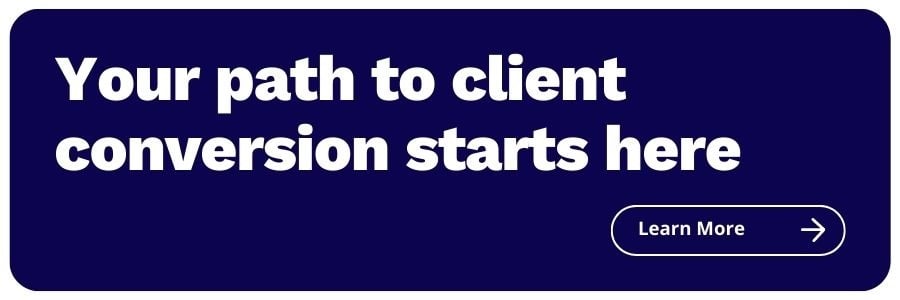A Winning Website: How to Convert your Firm's Website Visitors to Leads
Share this
As this baseball season is drawing to a close, I’m already daydreaming about off-season trades to maximize my team’s chances for next season. There is a lot of research and analysis that goes into what makes a winning club—the right combination of offense, defense, and let’s be honest, luck, make the difference in bringing home the hardware or heading home empty-handed.
Similarly, a winning website—one that converts site visitors into leads you can nurture to clients—requires the right strategy. You can attract all the web traffic you want, but if you’re not capturing visitor information to be able to move them toward conversion, well, that’s like winning the division only to go 0-3 in your first playoff series.
Just like there is no single formula for a World Series team, there is no one way to craft a website for conversion. But adding a strong slugger or star closer to your roster can stack the odds in your favor—no sign stealing required. Here’s my starting lineup of must-haves for converting site visitors into leads.
Define your balance of ungated vs. gated content
To make sure we’re speaking the same language, ungated content refers to anything on your website that is freely available to anyone. Gated content is anything a visitor can access only by providing their information.
Ungated content is key to driving traffic to your website. It helps improve your site’s authority by establishing your knowledge on the subject. It’s the description of your services and the market you serve that resonates with your ideal client. It’s the blogs you write showcasing your expertise on college savings or retirement planning. It’s your podcast transcriptions where you’ve discussed the latest tax changes.
Conversely, gated content’s sole purpose is to entice someone to give you their information—thereby generating new leads for your firm. The key to gated content’s success is that it is enticing enough to get a site visitor to turn over their information to you. The perceived value to the site visitor has to be higher than the cost of entry. While there is no secret playbook to define what is enticing, ensuring your content is relevant and well-positioned is critical.
Develop content offers
Once you’ve established a general plan for gated content, you need to create the content. These content offers—or freemiums—can come in a variety of formats, including (but definitely not limited to):
- Checklists
- Quizzes
- How-To Guides
- Worksheets
- Comparison Charts
- Templates
- Case Studies
- Calculators
- Benchmarking Reports
- eBooks
If you’re thinking a World Series run sounds easier than writing a few freemiums, I’ll let you in on a little secret—you don’t have to start from scratch on the content. Take a good inventory of what you’ve already produced. As you look at it, think about how it could look in a different format. The blog you wrote on different college savings options would be great as a sleek comparison chart. The podcast you hosted on changes to dependent care accounts could turn into a nice worksheet or calculator for estimating changes to withholdings.
Optimize your forms for conversion
There are a lot of studies around form length and the impact on conversion. While more recent research indicates the average number of form fields is 11, statisticians agree 3-5 fields will deliver the highest conversion rates. Beyond the number of fields, what information you are asking for has a significant impact on your form’s success. Not surprisingly, requiring a phone number leads to high abandonment rates; however, one study found that changing phone number from a mandatory field to optional decreased abandonment from 39% to 4%. Think about what information is critical to you connecting with your lead to inform you on what form fields you need to include.
Another killer of form conversions (and click-through rates in general) is the unknown. Is it clear to your site visitor what will happen when they submit your form? Be upfront with what their experience will be—will they receive an email of the content offer, or can they download it right away? Are they opting in to anything else? What can they expect to learn from the freemium?
Depending on your form provider, you may have the ability to make your forms “smart.” Sometimes called progressive fields or progressive profiling, this is essentially a one-to-one replacement of a field—as site visitors fill out more forms on your site, the form field you’ve already captured is replaced with the next field you have “queued” up. This allows you to discover more about your prospects without lengthening the submission processes.
Message the value
Which statement speaks to you more?:
Download a First-Year Budget Template
or
Budget for the First Year of Your RIA with our Fillable Template
Positioning or packaging your content so that the value and relevance to your audience are highlighted improves conversions. Get in the mindset of your buyer personas when you are writing the positioning for your freemiums. What are their pain points? What is important to them? Sharing how your content will address their needs makes conversion more likely than a no-hitter.
If you already have content offers on your site, a great exercise to help improve conversions is to review your existing landing pages and see if they pass the blink test—in 3-5 seconds could someone understand the value of your offer? Value is the key here. This is not about whether someone understands what the offer is, but how it will benefit them. Is the page header the actionable title of the offer (i.e., Download our {insert name of offer})? Try replacing the header with content that speaks directly to a specific persona or to state how a specific pain point will be addressed (i.e., the value statement). Then use the subheader for the actionable title (i.e., Download our…) and supporting content (short sentences and bullet points) to expand on specific values and details.
Build landing pages with purpose
Landing pages are different from the webpages on your site. Just as each player on a team has a specific position, your content offer landing pages have a specific role to play—conversion. To hyper-focus on the goal of the conversion, a landing page should remove all other “noise.” It’s not uncommon for landing pages to eliminate the primary navigation to not distract a site visitor into leaving your page before converting. If you choose to do this for your landing pages, I highly encourage you to create a "Thank You" page for site visitors to be directed to after they submit your form, which reintroduces the primary navigation so your visitors can continue to engage with your site.
A team’s starting pitcher sets the stage for the game’s success, and the top of your landing page does the same. While I generally dislike the term “above-the-fold” as it applies to web design, it is true that the most important content should be listed first. The top part of your landing page should include the value content you’ve already written and the submission form. While you don’t necessarily need anything else for your landing page, you can bulk it up (performance enhancement free) with content related to the freemium—a preview of what they will find or information about the author’s expertise on the subject. While internal linking (the practice of linking to another page within your site) is generally a best practice for web pages, I strongly discourage this for landing pages. Remember, the primary role of a landing page is to convert the site visitor so you want to minimize the distractions or opportunities to abandon the conversion as much as possible.
It’s all about stats
Baseball is a numbers game—pitch counts, batting averages, OPS, and RBIs. Managers obsess over each data point before, during, and after every game. As marketers (or the marketers of our firm), we should take a page out of their playbook. Monitoring the performance of your content offers and landing pages is the only way to understand the success.
Coming from someone who is responsible for a lot of data, it can be overwhelming. My best advice is to start small. Pick a few meaningful metrics that you are going to measure and then track them. For your content offers, important stats are unique pageviews and form submissions which then allow you to calculate your conversion rate. Depending on the platform you are using to host your landing pages and forms, all of this may be captured for you. Set a regular time to review this data and look for trends. By keeping an ongoing pulse on the performance of your campaigns, you know when you might need to make adjustments (i.e., amp up the value statements) or when you need to call in the bullpen (i.e., swap out a new content offer).
Teams spend years, sometimes decades, and millions of dollars building a World Series club. Fortunately, you don’t need to do either to create a website that drives home conversions. With some key plays, you can knock your prospect goals out of the park.
Good luck (and Go Twins)!

About the Author
As XYPN’s Marketing Systems Administrator and former Webmaster, Katie DeMars plays a major role in communicating XYPN’s value proposition to the world through digital mediums. Her career experiences span marketing and web roles giving her a unique perspective when approaching each project. Katie is passionate about creating exceptional virtual experiences and is excited to share XYPN’s story through digital platforms.
Share this
- Road to Launch with XYPN Member Alan Skillern, CFP®, MBA
- Coaching for Better Time Management: Prioritizing Organic Growth in Your Daily Routine
- Boost Your Financial Advisory Practice: SEO Strategies and CRM Optimization for Sales Success
- Navigating the AI Revolution: What Financial Advisors Need to Know
- Advisor Blog (692)
- Financial Advisors (221)
- Growing an RIA (99)
- Digital Marketing (87)
- Marketing (84)
- Community (81)
- Start an RIA (76)
- Coaching (72)
- Business Development (71)
- Running an RIA (70)
- Compliance (69)
- Client Acquisition (65)
- Technology (64)
- XYPN LIVE (59)
- Entrepreneurship (56)
- Sales (49)
- Practice Management (44)
- Client Engagement (41)
- XYPN Books (38)
- Bookkeeping (37)
- Investment Management (37)
- Fee-only advisor (36)
- Lifestyle, Family, & Personal Finance (31)
- Employee Engagement (30)
- Client Services (25)
- Financial Education & Resources (24)
- Journey Makers (21)
- Market Trends (21)
- Process (14)
- Niche (11)
- SEO (9)
- Scaling an RIA (9)
- Career Change (8)
- Transitioning Your Business (7)
- Partnership (6)
- Transitioning To Fee-Only (4)
- Social Media (3)
- Transitioning Clients (3)
- Emerald (2)
- Persona (2)
- RIA (2)
- Onboarding (1)
- Sapphire (1)
Subscribe by email
You May Also Like
These Related Stories

The Anatomy of a High-Converting Website
Nov 5, 2020
4 min read

Do's & Don'ts for Building Your Firm's Website
April 13, 2020
9 min read





